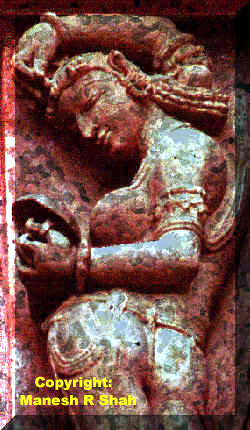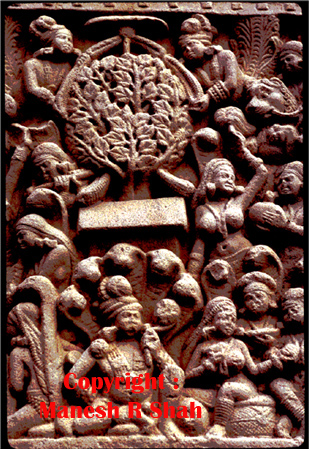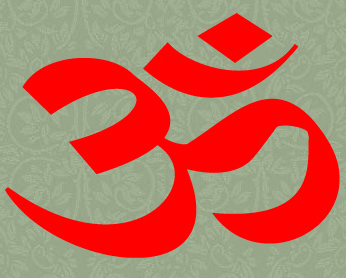

The word "Vedanta" translates as the end or conclusion of Vedas. The philosophical knowledge or discussions described in the Upanishads falls under what is called the Vedanta Philosophy. The phenomenal world, according to the Vedanta, is like a mirage in a desert, it excites thirst but does not quench it. Only that One metaphysical Primal Being called in Sanskrit by various murky names for the purpose of discussion only, namely Brahman is real. It must be observed here that what we perceive can never be the absolute Brahman, but a perverted picture only, just as the sun which we see manifold and tremulous in its ever changing reflections on the waving surface of the ocean, is not the real sun, though deriving its phenomenal character from the real sun which remains unaffected in its unapproachable remoteness. That One Brahman who is without a second ( Ekam Advityam ) is many times illustrated by a simile and described by metaphors. It must be understood by now that Brahman, the Eternal Subject, can not be equated to anything in the phenomenal universe or objective world since the two can not be ever equal. Hence, anything used from the phenomenal universe to illustrate Brahman is simply a metaphor or a simile. That one absolute and undetermined essence, what is called Brahman, could have received no impulse to change, for it was perfect, nor from others, for it was secondless. Hence, according to Vedanta, anything that can be destroyed or can change has no right to be called real. This includes the phenomenal universe, matter, energy as well as our mind, body and ego or what we call personality or individuality, all these are unreal. The Vedantist is a monist, denies reality of anything but that One Brahman, the Universal Being, which is to account for the whole of the phenomenal world.
The fundamental doctrine of Vedanta is :
There is nothing worth gaining, there is nothing worth enjoying, there is nothing worth knowing but Brahman alone, for he who knows Brahman, is Brahman.
We have another and still shorter abstract of the Vedanta in the famous words :
' Tat tvam asi,' meaning ' Thou art That.' The Tat is what is called in the Upanishads as the Brahman, the ultimate cause of the universe. The tvam is the atman or also called the Self. ( This is not an ordinary self or what is called ego or an individuality or a personality. It is that which reflects in the mind as the ' I ' - thought.) It is the highest aim of Vedanta to show that these two are in reality one.
In order to acquire this knowledge and achieve this deliverance from all suffering, from all limitation, from all the bondage of the world, man must learn what he really is. He must learn that he is not the body, for the body decays and dies, and with it all bodily sufferings might seem to end. But this is not the final freedom since a new ego would spring up, liable to suffer for its former acts, just as it did so in this life. A man must learn therefore that he is not even what is meant by the ego, for the ego also has been formed by surroundings or circumstances, and will vanish again like everything else. Then what remains? There remains behind the body, and behind the ego, or the individual person, what is called the Atman, the Self, and that Self is to be recognized either as identical with what was in earlier times conceived and called the Divine, the Eternal, the Unconditioned, namely, Brahman, perfect, independent, and absolute in itself, blissful in its independence and in the complete aloofness from everything else.
 The
discussion above is called Advaita Vedanta. Advaita means
non dual or monism. This is also called the path of knowledge or metaphorically
the path of the sun. This path mainly involves the use of mind to obtain Salvation
or Nirvana. It is realized as early as the Upanishads that Salvation
or Nirvana is the result of Grace of the Eternal. There are few methods that
have become identified with Advaita Vedanta that are used to turn mind
away from the objects and to the Eternal Subject or one could say to transcend
the mind.
The
discussion above is called Advaita Vedanta. Advaita means
non dual or monism. This is also called the path of knowledge or metaphorically
the path of the sun. This path mainly involves the use of mind to obtain Salvation
or Nirvana. It is realized as early as the Upanishads that Salvation
or Nirvana is the result of Grace of the Eternal. There are few methods that
have become identified with Advaita Vedanta that are used to turn mind
away from the objects and to the Eternal Subject or one could say to transcend
the mind.
One of the methods involves inquiring the famous question Who am I? or What is there real behind I? This method is best understood by the metaphor "Mind is a mirror". The objects reflect in the mind and produce corresponding thoughts about them in the mind. The entire objective universe reflects in the mind and is available to us as thoughts or names and/or forms. In other words, there is a thought that corresponds to an object in the objective universe except one, and that thought is the " I" - thought. The " I "-thought does not have anything in the objective universe corresponding to it. The question " Who am I? "really means whose reflection this " I " - thought is? It is not an invitation to start identifying with body or mind or personality or one's wealth. The question What is there real behind I? is easy to understand. It can't be body, mind, or ego since all these have beginning and an end, besides they change with time. Hence they are not real. The question is an attempt to turn the mind away from the world of change to the unchanging Eternal, from the phenomenal universe to the noumenal.
The other method which is quite popular is the rejection of thought. As mentioned earlier, the Eternal is beyond thought hence it is logical to reject every thought that arises in the mind.
An enlightened man may become free or obtain Salvation or Nirvana in this life. This is indeed the real object of Vedanta philosophy, to overcome all Avidva ( Nescience ), to become what the Atman always has been, namely Brahman, and to wait till death removes the last Upadhis or fetters, which, though they fetter the mind no longer, remain like broken chains on the mortal body. The Atman, having recovered its Brahmanhood, is even in this life so free from the body that it feels no longer any pain, and can not do anything, whether good or bad. This is the meaning of " akartakarta." This idea is largely misunderstood. It is meant no more than that Atman, which is above distinction of subject and object, of past and present, of cause and effect, is also by necessity above the distinction of good and evil. This never was intended as license to commit sinful acts nor claim any merit for good acts. The Atman being always at rest and blessed in itself and in Brahman.
Visishta - Advaita Philosophy

There have been other thinkers who have interpreted the ancient texts differently. Visishta Adavaita is one such system. It is also called the doctrine of unity with attributes or Monism with a difference. Brahman here too is the highest reality, omnipotent, omniscient, but this Brahman at the same time full of compassion or love. This is in contrast to the earlier system in which Brahman is considered without any qualities. Souls as individuals posses reality in this system. What perceives and what does not perceive , soul and matter, form the body of Brahman. There is always Ishvar as a third, the Lord, who is regarded as Vishnu. It assumed the greatest importance as a religious sect, as teaching people how to live rather than how to think.
Brahman, whether under the name of Ishvar, or Vishnu is considered both the efficient as well as the material cause of all that exists, and he is likewise the lord and ruler of the world. Individual souls ( Giva ) spring from this Brahman who has qualities like Jnana ( Knowledge ), Sakti ( Energy ), Bala ( Strength ), Aisvarya ( Supreme Power ), Virya ( Vigor ) and Tegas ( Light ). Besides these qualities, Brahman is supposed to posses, as constituent elements, the material world and the individual souls, and to act as the inward ruler ( Antaryamin ) of them. This system gave its followers not only their own souls, but also a personal god.
The Vedanta philosophers of India, though they look on the ancient texts of Upanishads as the authority, often present a body of doctrine independent of them; colonies, as it were, of thought that had grown to be independent of mother country, but are anxious nevertheless to prove that their own doctrines can be reconciled with the old authorities. It must be admitted therefore that in India, instead of one Vedanta philosophy, we have two springing from the same root but extending it's branches in two very different directions, one of Advaita Vedanta for unflinching reasoners who, supported by an unwavering faith in Monism, do not shrink from any of its consequences; another that of Visishta Advaita trying hard to reconcile their Monism with the demands of human heart that required, and always will require, a personal god, as the last cause of all that is, and a soul that yearns for an approach to or a union with that being.